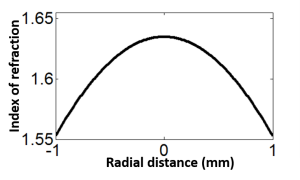Difference between revisions of "GRIN Lens Information"
From UCLA Miniscope
| Line 1: | Line 1: | ||
[[File:GRINProfil.png|thumb|300px|Example index of refraction profile of a 2mm diameter lens.]] | [[File:GRINProfil.png|thumb|300px|Example index of refraction profile of a 2mm diameter lens.]] | ||
| − | GRadient INdex (GRIN) lenses use a non uniform index of refraction to shape light instead of surface curvature as with standard lenses. | + | GRadient INdex (GRIN) lenses use a non uniform index of refraction to shape light instead of surface curvature as with standard lenses. Our system uses a cylindrical GRIN lens which is implanted within 200um of the structure of interest. For a given GRIN lens, its focusing property can be adjusted by changing the pitch of the lens which is directly related to the lens length. |
| + | *Advantages of GRIN lenses | ||
| + | **Extremely small to zero working distance | ||
| + | **Optical properties tune-able by changing lens length | ||
| + | **Affordable | ||
| + | **Small size (down to 0.5mm in diameter) | ||
| + | **Compatible | ||
| + | *Disadvantages of GRIN lenses | ||
| + | **No optimal index of refraction profile for imaging applications | ||
| + | **The majority of commercially available GRIN lenses are not optimized for imaging applications (discussed below) | ||
| + | **People have experienced supply issues from some suppliers (discussed below) | ||
== GRIN Lens Optics == | == GRIN Lens Optics == | ||
| + | |||
== GRIN Lens Issues == | == GRIN Lens Issues == | ||
| − | == GRIN Lens | + | == GRIN Lens Suppliers == |
Revision as of 20:40, 7 January 2016
GRadient INdex (GRIN) lenses use a non uniform index of refraction to shape light instead of surface curvature as with standard lenses. Our system uses a cylindrical GRIN lens which is implanted within 200um of the structure of interest. For a given GRIN lens, its focusing property can be adjusted by changing the pitch of the lens which is directly related to the lens length.
- Advantages of GRIN lenses
- Extremely small to zero working distance
- Optical properties tune-able by changing lens length
- Affordable
- Small size (down to 0.5mm in diameter)
- Compatible
- Disadvantages of GRIN lenses
- No optimal index of refraction profile for imaging applications
- The majority of commercially available GRIN lenses are not optimized for imaging applications (discussed below)
- People have experienced supply issues from some suppliers (discussed below)
